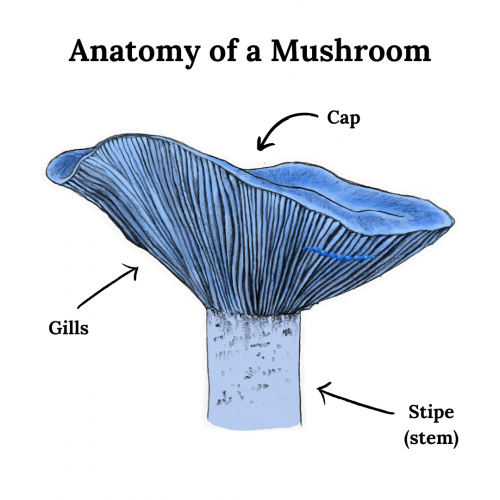What are fungi?
Although ~155,000 species of fungi have been identified, scientists estimate that more than 2.5 million fungal species exist on Earth. Out of these millions of species, not all are edible. And out of the edible ones… not all are what fungal scientists, or mycologists, would call “mushrooms!”

“Mushroom” is the colloquial term for fleshy, macroscopic fungi that grow in that typical “mushroom shape,” including a stipe (stem) and a cap. Some mushrooms that are commonly eaten include cremini, portobello, oyster, shiitake, enoki, morel, and chanterelle.
Some non-mushroom fungi that we often eat include yeasts, which are used in the fermentation of bread and alcohol, and molds, which are used to make stinky cheeses like camembert and gorgonzola.
Fungi are nutritious
Edible fungi contain proteins, nutrients, vitamins, and enzymes that can make for a nutritious and balanced diet.
Edible fungus-based proteins are called mycoproteins. One common example of this is Quorn, a fermented protein made from the fungus Fusarium venenatum. This protein alternative has been popular with vegetarians for decades, but with innovation, can be a tasty protein for all diets. Additionally, mycoproteins are much lower in cholesterol than animal proteins.
Mushrooms contain many vitamins and nutrients, especially ones that are difficult to get from non-animal sources. Some examples include B vitamins, selenium, copper, iron, and vitamin D2, which is especially important for bone health.
Fungi are a sustainable food source
Fungi and mushroom cultivation have a much lower carbon footprint than animal cultivation and can even increase the efficiency of fruit and vegetable farming.
Mushrooms are space and energy efficient. Since the organisms themselves derive their nutrition from the substrate around them, rather than photosynthesizing like plants, mushrooms can be grown indoors without light.
Some farmers choose to cultivate mushrooms in their fields between major growing seasons to keep cash flow. These mushrooms can improve the soil quality in the field, reducing the need for extra fertilizers during the next growth period.
A versatile ingredient
Fungi have thick cell walls made of chitin, which gives them their signature chew. This also helps them keep their structure when cooked down. And yes, all mushrooms should be cooked before eating, as this makes the chitin easier for our stomachs to digest.
When cooked, mushrooms lose some of their water content and sponge up the flavors around them, so you can season them however you’d like! Mushrooms are delicious when dropped into a low-and-slow stew or a flavorful hotpot broth, and can be a tasty topping on pizzas, pasta, and salads.
Grow mushrooms at home!
While many mushrooms are available at the supermarket, growing your own at home can be a fun activity. Oyster and shiitake mushrooms are great species for beginners to try. Credible mushroom-growing kits include instructions on how to get started.
Never forage unless you are completely sure of the species.
Still curious about fungi? Check out this past May’s feature story, The Mysterious Kingdom of Fungi!